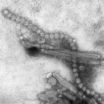(Press-News.org) Despite no lapses in the disinfection process recommended by the manufacturer being identified, specialized gastrointestinal endoscopes called duodenoscopes had bacterial contamination associated with an outbreak of a highly resistant strain of E coli at a hospital in Illinois, according to a study in the October 8 JAMA, a theme issue on infectious disease.
The duodenoscope is different than that used for routine upper gastrointestinal endoscopy or colonoscopy. The procedure associated with these specialized scopes is endoscopic retrograde cholangiopancreatography (ERCP), an important and potentially lifesaving medical procedure that allows doctors to diagnose and treat life-threatening problems in the bile and pancreatic ducts.
Carbapenem-resistant Enterobacteriaceae (CRE) are multidrug-resistant organisms isolated predominantly from patients with exposures in health care facilities. CRE are a public health concern because treatment options are limited and invasive infections are associated with a risk of death. The New Delhi metallo-beta-lactamase (NDM) is a carbapenemase (an enzyme that breaks down antibiotics) that has been infrequently reported in the United States. However, NDM-producing CRE have the potential to add substantially to the total CRE burden. Understanding transmission and preventing further spread of CRE is a public health priority, according to background information in the article.
In March 2013, NDM-producing Escherichia coli was identified from a patient at a teaching hospital in Illinois. Between March 2013 and July 2013, 6 additional patients with a history of admission to this hospital had positive clinical cultures for NDM-producing E coli. In August 2013, Lauren Epstein, M.D., M.Sc., of the Centers for Disease Control and Prevention, Atlanta, and colleagues launched an investigation to identify the source and prevent further NDM¬-producing CRE transmission at this hospital. Interviews were conducted with health care personnel at the hospital.
A medical record review revealed that a history of ERCP procedures involving the use of a duodenoscope was common among initial cases. In total, 39 case patients were identified from January 2013 through December 2013, 35 with duodenoscope exposure. In this outbreak, 39 patients with NDM-producing CRE were identified from January 2013 – December 2013, 35 with duodenoscope exposure in 1 hospital. Some of those patients had positive blood cultures, often an indication of infection and others were found to be colonized with CRE but did not have a CRE infection.
NDM-producing E coli was recovered from a reprocessed duodenoscope and shared similarity to all case patient isolates. Based on a case-control study, case patients had significantly higher odds of being exposed to a duodenoscope. The authors write that the large number of exposed patients that ultimately had NDM-producing CRE isolated from clinical or screening cultures suggests that duodenoscopes were an efficient source of transmission.
An infection prevention assessment that focused on duodenoscope reprocessing (such as cleaning) was conducted, and it was found that the hospital followed all manufacturer-recommended procedures. After the hospital changed its duodenoscope reprocessing to a gas sterilization procedure, no additional case patients were identified.
"The complicated design of duodenoscopes makes cleaning difficult. It appears that these devices have the potential to remain contaminated with pathogenic bacteria even after recommended reprocessing is performed," the researchers write. They add that another option for ensuring adequate duodenoscope reprocessing might be to conduct testing for residual contamination during reprocessing. "Many international professional societies recommend periodic microbiological surveillance testing of duodenoscopes after full reprocessing."
"Facilities should be aware of the potential for transmission of antimicrobial-resistant organisms via this route and should conduct regular reviews of their duodenoscope reprocessing procedures to ensure optimal manual cleaning and disinfection."
(doi:10.1001/jama.2014.12720; Available pre-embargo to the media at http://media.jamanetwork.com)
Editor's Note: Please see the article for additional information, including other authors, author contributions and affiliations, financial disclosures, funding and support, etc.
Editorial: Gastrointestinal Endoscopes - A Need to Shift From Disinfection to Sterilization?
William A. Rutala, PhD., M.P.H., and David J. Weber, M.D., M.P.H., of University of North Carolina Health Care, Chapel Hill, comment on the findings of this study in an accompanying editorial.
"Clinicians should be encouraged to report and publish cases of infectious diseases related to endoscopy, especially if current reprocessing methods were adhered to, so it can be determined if the report by Epstein et al is the tip of the iceberg or an isolated occurrence. If the former, then revision of the endoscope reprocessing guidelines will be necessary to ensure patient safety. However, regardless of when these issues are resolved, endoscopy will remain an important diagnostic and therapeutic modality and should continue to be used while clinicians strictly adhere to current endoscope reprocessing guidelines."
INFORMATION:
(doi:10.1001/jama.2014.12559; Available pre-embargo to the media at http://media.jamanetwork.com)
Editor's Note: Please see the article for additional information, including financial disclosures, funding and support, etc.
Study participants who reported tobacco use or had higher levels of biomarkers of tobacco exposure had a higher prevalence of the sexually transmitted infection, oral human papillomavirus type 16 (HPV-16), according to a study in the October 8 JAMA, a theme issue on infectious disease.
Oral HPV-16 is believed to be responsible for the increase in incidence of oropharyngeal squamous cell cancers in the United States. An association between self-reported number of cigarettes currently smoked per day and oral HPV prevalence has been observed, according to background information ...
Johns Hopkins scientists have shown a strong association between tobacco use or exposure and infection with oral human papillomavirus type 16 (HPV16), the sexually transmitted virus responsible for mouth and throat cancers worldwide. The numbers of such cancers have increased 225 percent in the United States over the past two decades.
HPV16 is found in 80 percent of cancers located in the back of the throat and is transmitted through oral sex. "The practice of oral sex is common, but this cancer is rare. So there must be cofactors in the process that explain why some ...
ANN ARBOR, Mich. — A decade ago, America's health care community took on heart attacks with gusto, harnessing the power of research and data to make sure that every patient got the best possible care.
It worked: Death rates for heart attack have dropped. The same has happened with heart failure and pneumonia. Now, say a pair of University of Michigan Medical School experts, it's time to do the same for sepsis.
Sepsis may not have the same name recognition as heart attacks -- but it now affects more hospital patients, and leads to more hospital costs, than any ...
An experimental vaccine to protect people against H7N9 avian influenza prompted immune responses in 59 percent of volunteers who received two injections at the lowest dosage tested, but only if the vaccine was mixed with adjuvant—a substance that boosts the body's response to vaccination. Without adjuvant, immune responses produced by the investigational vaccine were minimal regardless of vaccine dosage, according to findings from a clinical trial sponsored by the National Institute of Allergy and Infectious Diseases (NIAID), part of the National Institutes of Health.
The ...
A large, NIH-sponsored clinical trial of an experimental H7N9 avian influenza vaccine found an immune response that was believed to be protective in 59 percent of study participants who received two injections of the inactivated vaccine at the lowest dosage tested when mixed with an adjuvant – a component that boosts the body's immune response and enhances the effectiveness of inactivated influenza vaccines.
Participants who received a vaccine without the adjuvant had a minimal immune response.
The results are published in the Journal of the American Medical ...
VIDEO:
This video shows the sole of a shoe as it appears from different perspectives in rendering software. The shoe was placed upside down on an optical table (seen as flat...
Click here for more information.
Researchers at the National Institute of Standards and Technology (NIST) have demonstrated a laser-based imaging system that creates high-definition 3D maps of surfaces from as far away as 10.5 meters.* The method may be useful in diverse fields, including precision machining ...
(SALT LAKE CITY)—University of Utah biochemists have reported a new drug discovery tool against the Ebola virus. According to a study published in this week's online edition of Protein Science, they have produced a molecule, known as a peptide mimic, that displays a functionally critical region of the virus that is universally conserved in all known species of Ebola. This new tool can be used as a drug target in the discovery of anti-Ebola agents that are effective against all known strains and likely future strains.
The University of Utah (U of U) work, which was ...
The link between low average glucose blood levels and greater risk for severe hypoglycemia and hypoglycemic coma substantially declined between 1995 and 2012 in young Germans and Austrians with type 1 diabetes, according to a study published by Beate Karges and colleagues from the RWTH Aachen University, Germany in this week's PLOS Medicine.
The researchers obtained measurements of average blood glucose levels (measured as HbA1c) and the incidents of severe hypoglycemia and hypoglycemic coma from 37,539 children and young adults with type 1 diabetes between 1995 and 2012 ...
Treatment with dimercaptosuccinic acid (DMSA), an oral chelation agent, was linked to reductions in the amount of lead in blood in young children in Zamfara State, Nigeria following environmental lead contamination, according to a study by Jane Greig and colleagues from Médecins Sans Frontières (MSF) published in this week's PLOS Medicine.
The researchers report findings from an MSF program initiated in May 2010 to reduce lead poisoning in children following widespread environmental lead contamination due to gold mining in Zamfara State, Nigeria, leading to ...
A fundamental question in neurobiology is how animals, including humans, make decisions. A new study publishing in the open access journal PLOS Biology on October 7 reveals how fruit fly females make a very important decision: to either accept or reject male courtship. This decision appears to be generated by a very small number of excitatory neurons that use acetylcholine as their neurotransmitter located in three brain regions. This study provides the framework to understand how decisions are generated and suggests that a decision is reached because that option is literally ...

